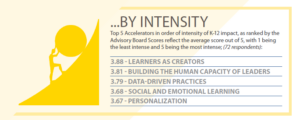The COSN 2020 K12 Driving Innovation: Accelerators report, after multiple rounds of Delphi-like voting by more than 102 members of their International Advisory Board of distinguished educational technology experts, has a lot to say about trendsetting ed-tech developments, developments which help speed up the rate of technology innovation in the educational marketplace.


In this second in my series of three articles we will focus on five accelerators that, according to the Driving K12 Innovation expert panel, will potentially spur ed-tech adoption to higher levels.
Although the 2020 Driving Innovation: Accelerators report largely speaks for itself, in this piece I will offer a bit of translation and connection. With full disclosure, I must mention that I served as one of the 102 world-wide panelists who developed this report over many months. Serving as a panelist for the report for the last seven years (Driving K–12 Innovation is the successor to the New Media Consortium’s Horizon K–12 reports, a decade-long series that ended in 2017), I can add beneficial nuance to the findings, from an inside perspective. The full report can be accessed here. A full translation in Chinese can be found here.
To begin, let’s ask ourselves “What is an accelerator?” Accelerators can be viewed as accompanying trends that help pave the way for your products to succeed in schools. Like the well-worn aphorism suggests, “a rising tide lifts all boats”. Another useful aphorism is the idea of “riding on someone else’s coattails”, that is, to earn greater advantage by smartly attaching our products to the successful growth of a favorable idea already gaining traction in the education market. With that in mind, let’s take a quick look at the five recognized innovation accelerators for 2020, ranked by their level of intensity of potential K12 impact, along with my commentary:
![]() Learners as Creators
Learners as Creators
The chief accelerator for this year, returning again to the list for a second time, involves the students-as-creators phenomenon. The last few years have witnessed a steady and slow movement towards the ‘prosumer’ in education, the growing validity of and demand for student to create their own content, not merely to be filled with someone else’s content. When students take the reins, so to speak, technology efforts in schools are energized and transformed. In short, latching your products onto this trend will help catalyze your sales.
![]() Building Human Capacity of Leaders
Building Human Capacity of Leaders
In past articles, I’ve frequently warned that education leaders are often not very ‘tech savvy”. Carefully helping these leaders navigate the waters of technology innovation can serve as a catalyst to success and scaling in their schools and districts. Specifically, building up their planning and implementation ‘chops’, goes a long way in turbocharging technology in schools. Leaders matter in education, so a focus on helping education leaders to understand your technology (from their point of view) can help your cause immeasurably.
![]() Data-driven Practices
Data-driven Practices
According to the report, schools are leveraging data more and more “to make decisions about curriculum, hiring, teaching and learning, and technology investments”. The report adds: “school leaders are [increasingly] using data visualization to view academic and operational outcomes”. Valuing and chasing data supercharges the importance of technology from the superintendent’s office down to the teacher’s desk.
![]() Social and Emotional Learning (SEL)
Social and Emotional Learning (SEL)
This topic is new to the accelerators list this year, but it is a rising-star movement I have covered closely for several years now in Display Daily articles. According to the report, SEL involves “learning experiences that help build students’ character and identity…”; social/emotional learning includes building “empathy, grit, persistence, flexibility, and adaptability” in students. Social and emotional growth is slowly becoming as important as academic growth in schools these days, because SEL is seen as setting the table for success in academic progress. To see how widespread and how important SEL has become in schools these days, explore this enlightening interactive map. Figuring out how to link your products to the remarkable trajectory of SEL in K12 education is well worth your time.
![]() Personalization
PersonalizationAnother repeat appearance on the accelerators list from last year is the newest take on ‘individualized” learning in schools. ‘Personalized’ learning allows for students to pursue their own pace, pathways and choices in their schooling. Personalization is viewed as a key ‘accelerator’ of innovation because students often must work independently (requiring a lot of technology) and not be so tightly bound to the customary “teacher-on-the-stage” environment. Personalized learning also tends to build on the notion of the leaner-as-creator, which was discussed in detail above.
Each of these ‘accelerators’ enables your teaching/learning products to advance in the market at a much faster rate. It’s also interesting to note that most of these accelerators place students at the heart of the learning enterprise. My hope is that, by dissecting this report, it helps not only with an understanding of the memes now shaping the educational marketplace, it will also supply some of the key nomenclature that will help your product messaging resonate with educational customers. I also am suggesting each of these accelerators can also be viewed as an opportunity to leverage your products or services in light of the newest priorities of educators. – Len Scrogan

